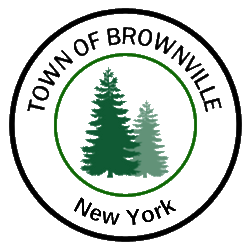IMPORTANT INFORMATION ABOUT
TOWN OF BROWNVILLE WD 2 DRINKING WATER
The Town of Brownville WD #2 exceeded the Maximum Contaminant Level (MCL) of 60 ug/L for
Haloacetic Acids (HAA5) present in drinking water. During the four calendar quarters ending September 30, 2022, the locational running annual average (LRAA) for haloacetic acids was 67.1 mircograms per liter at the entry point, 60.2 micrograms per liter at the mid-point, and 63.8 micrograms per liter near the end point of the distribution system. This level is based on a locational running annual average of quarterly samples, Although this is not an emergency, as our customers, you have a right to know what you should do, where these contaminants came from, and what is being done.
What should 1 do?
You do not need to boil your water or take other corrective actions. No immediate action is required or necessary.
Where do HAA5’s come from?
Haloacetic acids are a group of chemicals that includes mono-, di- and trichloroacetic acids and mono- and dibromoacetic acids. Haloacetic acids are formed in drinking water during treatment by chlorine, which reacts with certain acids that are in naturally-occurring organic material (e.g., decomposing vegetation such as tree leaves, algae or other aquatic plants) in surface water sources. The amount ofhaloacetic acids in drinking water can change from day to day, depending on the temperature, the amount of organic material in the water, the amount of chlorine added, and a variety of other factors. Drinking water is disinfected by public water suppliers to kill bacteria and viruses that could cause serious illnesses. Chlorine is the most commonly used disinfectant in New York State. For this reason, disinfection of drinking water by chlorination is beneficial to public health.
Some studies of people who drank chlorinated drinking water for 20 to 30 years show that long term exposure to disinfection by-products (possibly including haloacetic acids) is associated with an increased risk for certain types of cancer. However, how long and how frequently people actually drank the water as well as how much haloacetic acids the water contained is not known for certain. Therefore, we do not know for sure if the observed increased risk for cancer is due to haloacetic acids, other disinfection by-products, or some other factor. The individual haloacetic acids dichloroacetic acid and trichloroacetic acid cause cancer in laboratory animals exposed to high levels over their lifetimes. Dichloroacetic acid and trichloroacetic acid are also known to cause other effects in laboratory animals after high levels of exposure, primarily on the liver, kidney and nervous system and on their ability to bear healthy offspring, Chemicals that cause effects in animals after high levels of exposure may pose a risk to humans exposed to similar or lower levels over long periods of time.
What happened and what is being done?
The combination of the quantity of disinfectant needed and the amount of naturally occurring organic material in the incoming water resulted in a level of HAA5’s in excess ofthe MCL. In order to kill disease-causing microorganisms, water treatment regulations require a certain contact time for the chlorine and water before it enters the distribution system. Town of Brownville personnel are currently working to identify solutions to this problem.
If you have any questions, please contact Mr. Roy Gilchrist at (315) 639-6317 or the New York State Department of Health, Watertown District Office at (3 15) 785-2277.
